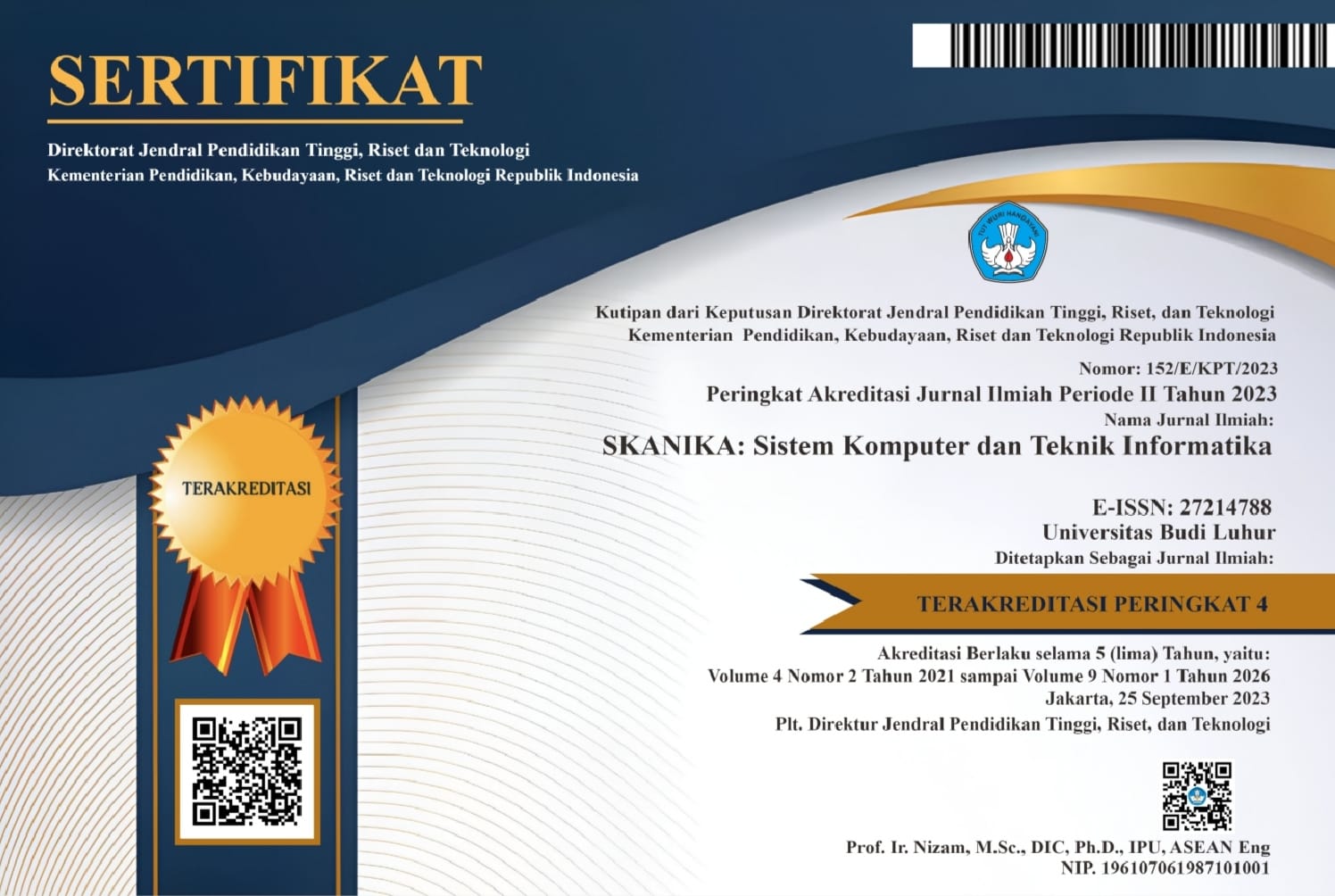PROTOTIPE SISTEM PAKAR UNTUK DIAGNOSIS PENYAKIT INFEKSI SALURAN PERNAPASAN (ISPA) MENGGUNAKAN METODE CERTAINTY FACTOR
Abstract
Respiratory Tract Infection is a condition that triggers inflammation of the upper respiratory tract, such as the nose, throat, sinuses, and airways leading to the lungs. Symptoms such as runny nose, cough, sore throat, nasal congestion, sneezing, and fever appear. Because the symptoms are often similar to other diseases, people with respiratory infections are often unaware of their condition. For this reason, a system that can diagnose respiratory infection symptoms quickly and accurately is needed. By integrating biology and artificial intelligence (AI), a biotechnology expert system for respiratory tract infections was developed. The Certainty Factor method is used to assess the level of confidence in a symptom based on the beliefs of an expert. The system is designed for the general public to receive examination results in the form of percentages, which help identify whether the symptoms experienced fall into the category of sinusitis, pneumonia, pharyngitis, or asthma. The doctor's question feature as a development of the previous system, allows users to consult with doctors about the symptoms experienced. The test results that have been carried out show that the results are in accordance with manual calculations. In addition, the system accuracy test resulted in an accuracy value of 80%.
Downloads
References
[2] E. Erlindai, Y. G. Nengsih, P. Saragih, and R. A. Sinaga, “Application of the Certainty Factor Method for the Expert System for Diagnosing ISPA Disease (Acute Respiratory Infection) in Children Based on the Website,” J. Info Sains Inform. dan Sains, vol. 13, no. 02, pp. 337–344, 2023.
[3] M. T. Hidayatuloh and T. N. Suharsono, “Sistem Pakar Diagnosis Penyakit Infeksi Saluran Pernapasan Akut (ISPA) Menggunakan Metode Dempster Shafer Universitas Sangga Buana YPKP, Indonesia,” Digital Transformation Technology (Digitech), vol. 3, no. 2, pp. 489–498, 2023.
[4] D. Gusmaliza and R. Masdalipa, “Sistem Pakar Diagnosa Penyakit ISPA dengan Metode Forward Chaining,” JOINTECTS: Journal of Information Technology and Computer Science, vol. 3, no. 4, pp. 738–746, 2022.
[5] S. A. Putri, M. Dahria, and R. Kustini, “Sistem Pakar Mendiagnosa Penyakit Ispa Fase Akut Pada Anak Usia Dini Dengan Menggunakan Metode Theorema Bayes,” Jurnal Cyber Tech, vol. 2, no. 5, pp. 1–18, 2021.
[6] N. Fadila and R. Tanamal, “Penerapan Rule-Based Expert System (RBES) Dalam Perancangan Aplikasi Sistem Pakar Untuk Mendiagnosa Penyakit Infeksi Saluran Pernapasan Akut (ISPA) Berbasis Android,” J. Ilm. Teknol. Inf. Asia, vol. 15, no. 2, p. 115, 2021.
[7] F. F. W. Ramadhana, “Aplikasi sistem pakar untuk mendiagnosa penyakit ispa menggunakan metode naive bayes berbasis website,” STRING (Satuan Tulisan Ris. dan Inov. Teknol., vol. 4, no. 3, pp. 320–329, 2020.
[8] A. Gunawan and T. M. Yanti, “Sistem Pakar Diagnosa Penyakit Ispa (Infeksi Saluran Pernapasan Akut) Menggunakan Metode Fuzzy Logic Berbasis Web Mobile,” JUTIM (Jurnal Tek. Inform. Musirawas), vol. 6, no. 2, pp. 154–165, 2021.
[9] D. Maulina, A. M. Wulanningsih, “Metode Certainty Factor Dalam Penerapan Sistem Pakar Diagnosa Penyakit Anak,” JOISM: Journal of Information System Management, vol. 2, no. 1, pp. 23–32, 2020.
[10] F. Fitriyadi, T. F. Efendi, and M. Erkamim, “Perancangan Interface Sistem Pakar Diagnosa Penyakit Tanaman Cabai dengan Metode Extreme Programming (XP),” JIKOBIS: Jurnal Informatika, Komputer dan Bisnis, vol. 1, no. 1, pp. 39-47, 2021.
[11] M. F. J. K. Luid, A. A. Bouty, and I. R. Padiku, “Sistem Pakar Untuk Perencanaan Karir Dengan Algoritma Forward Chaining Berbasis Web,” DIFFUSION: Journal of System and Information Technology, vol. 4, no. 1, pp. 115–125, 2024.
[12] T. F. Ramadhani, I. Fitri, and E. T. E. Handayani, “Sistem Pakar Diagnosa Penyakit ISPA Berbasis Web Dengan Metode Forward Chaining,” JOINTECTS: Journal of Information Technology and Computer Science, vol. 3, no. 28, pp. 81–90, 2022.
[13] D. P. P. N. Abdurahman, I. Jamaludin, E. D. S. Mulyani, “Sistem Pakar Diagnosa Penyakit ISPA Dengan Menggunakan Metode Certainty Factor Berbasis Web,” JUSITI: Jurnal Sistem Informasi dan Teknologi, vol. 11, no. 2, pp. 112–123, 2022.
[14] J. Kalyzta and M. Syafrullah, “Sistem Pakar Diagnosa Kerusakan Komputer Dengan Algoritma Certainty Factor Pada Lab Ict Budi Luhur,” SKANIKA, vol. 6, no. 1, pp. 12–21, 2023.
[15] S. Njoo, K. Gunadi, and H. N. Palit, “Sistem Pakar Pendiagnosa Infeksi Saluran Pernafasan Akut (ISPA) dengan Metode Forward Chaining dan Certainty Factor,” Jurnal Infra, vol. 9, no. 2, pp. 1-7, 2021.













